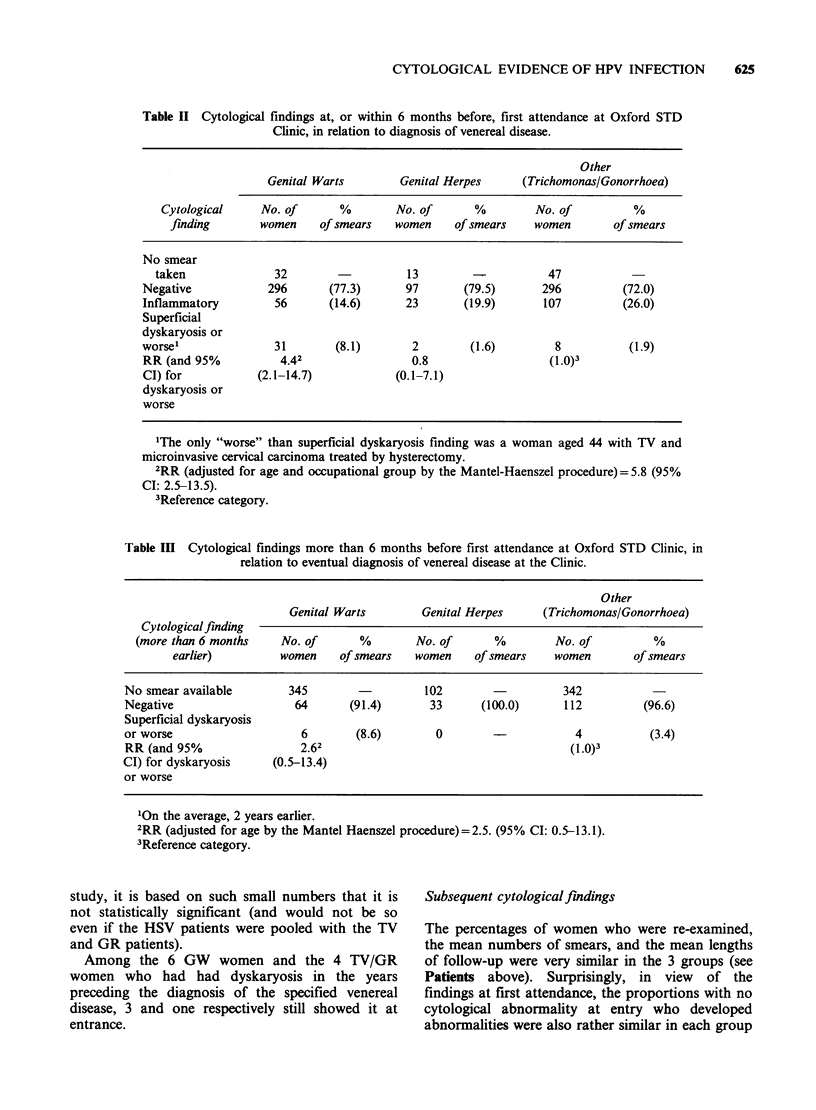Abstract
Cervical carcinoma and cervical intra-epithelial neoplasia (CIN) are likely to be associated with all sexually transmitted diseases (STDs). To help discover which (if any) of the recognised STDs might actually cause these conditions, a key question is whether one particular such association is much stronger than the others. The present study is therefore only of women newly attending an STD clinic, and compares the prevalences of cytological abnormalities of the cervix among 415 women attending with genital warts, 135 with genital herpes, and 458 with trichomoniasis or gonorrhoea. Significantly more genital wart patients (8.1%) than trichomoniasis or gonorrhoea patients (1.9%) showed dyskaryotic changes (adjusted relative risk (RR) = 5.8 with 95% limits 2.5-13.5) at, or a few months before, first attendance, while no excess whatever was seen in women with genital herpes. Moreover, half the women had a subsequent smear (at an average of 3-4 years after first attendance) and, although the diagnosis at first attendance was not related to the onset rate of dyskaryotic changes observed in these subsequent smears, it was related to the onset rate of grade III cervical intra-epithelial neoplasia (CIN III), which was found in 7 previous genital wart patients, in 2 previous trichomonas patients, but in 0 previous genital herpes patients. Thus, our findings suggest that herpes is not directly relevant to dyskaryotic change, but that one or more of the human papilloma viruses that cause genital warts may be.
Full text
PDF







Selected References
These references are in PubMed. This may not be the complete list of references from this article.
- Alexander E. R. Possible etiologies of cancer of the cervix other than herpesvirus. Cancer Res. 1973 Jun;33(6):1485–1490. [PubMed] [Google Scholar]
- Baggish M. S. Carbon dioxide laser treatment for condylomata acuminata venereal infections. Obstet Gynecol. 1980 Jun;55(6):711–715. [PubMed] [Google Scholar]
- Boon M. E., Fox C. H. Simultaneous condyloma acuminatum and dysplasia of the uterine cervix. Acta Cytol. 1981 Jul-Aug;25(4):393–399. [PubMed] [Google Scholar]
- Boxer R. J., Skinner D. G. Condylomata acuminata and squamous cell carcinoma. Urology. 1977 Jan;9(1):72–78. doi: 10.1016/0090-4295(77)90291-6. [DOI] [PubMed] [Google Scholar]
- Eglin R. P., Sharp F., MacLean A. B., Macnab J. C., Clements J. B., Wilkie N. M. Detection of RNA complementary to herpes simplex virus DNA in human cervical squamous cell neoplasms. Cancer Res. 1981 Sep;41(9 Pt 1):3597–3603. [PubMed] [Google Scholar]
- Jagella H. P., Stegner H. E. Zur Dignität der Condylomata acuminata. Klinische, histopathologische und cytophotometrische Befunde. Arch Gynakol. 1974 Mar 12;216(2):119–132. doi: 10.1007/BF00668386. [DOI] [PubMed] [Google Scholar]
- Kessler I. I. Human cervical cancer as a venereal disease. Cancer Res. 1976 Feb;36(2 Pt 2):783–791. [PubMed] [Google Scholar]
- MANTEL N., HAENSZEL W. Statistical aspects of the analysis of data from retrospective studies of disease. J Natl Cancer Inst. 1959 Apr;22(4):719–748. [PubMed] [Google Scholar]
- Miettinen O. Estimability and estimation in case-referent studies. Am J Epidemiol. 1976 Feb;103(2):226–235. doi: 10.1093/oxfordjournals.aje.a112220. [DOI] [PubMed] [Google Scholar]
- Problems of cell nomenclature in cervical cytology smears. Recommendations of a working party of the British Society for Clinical Cytology. J Clin Pathol. 1978 Dec;31(12):1226–1227. doi: 10.1136/jcp.31.12.1226. [DOI] [PMC free article] [PubMed] [Google Scholar]
- Purola E., Savia E. Cytology of gynecologic condyloma acuminatum. Acta Cytol. 1977 Jan-Feb;21(1):26–31. [PubMed] [Google Scholar]
- Reid R., Laverty C. R., Coppleson M., Isarangkul W., Hills E. Noncondylomatous cervical wart virus infection. Obstet Gynecol. 1980 Apr;55(4):476–483. [PubMed] [Google Scholar]
- Reid R., Stanhope C. R., Herschman B. R., Booth E., Phibbs G. D., Smith J. P. Genital warts and cervical cancer. I. Evidence of an association between subclinical papillomavirus infection and cervical malignancy. Cancer. 1982 Jul 15;50(2):377–387. doi: 10.1002/1097-0142(19820715)50:2<377::aid-cncr2820500236>3.0.co;2-a. [DOI] [PubMed] [Google Scholar]
- Shevchuk M. M., Richart R. M. DNA content of condyloma acuminatum. Cancer. 1982 Feb 1;49(3):489–492. doi: 10.1002/1097-0142(19820201)49:3<489::aid-cncr2820490316>3.0.co;2-u. [DOI] [PubMed] [Google Scholar]
- Shokri-Tabibzadeh S., Koss L. G., Molnar J., Romney S. Association of human papillomavirus with neoplastic processes in the genital tract of four women with impaired immunity. Gynecol Oncol. 1981 Oct;12(2 Pt 2):S129–S140. doi: 10.1016/0090-8258(81)90068-8. [DOI] [PubMed] [Google Scholar]
- Syrjänen K. J., Heinonen U. M., Kauraniemi T. Cytologic evidence of the association of condylomatous lesions with dysplastic and neoplastic changes in the uterine cervix. Acta Cytol. 1981 Jan-Feb;25(1):17–22. [PubMed] [Google Scholar]
- Waterson A. P. Human cancers and human viruses. Br Med J (Clin Res Ed) 1982 Feb 13;284(6314):446–448. doi: 10.1136/bmj.284.6314.446. [DOI] [PMC free article] [PubMed] [Google Scholar]
- zur Hausen H. Human genital cancer: synergism between two virus infections or synergism between a virus infection and initiating events? Lancet. 1982 Dec 18;2(8312):1370–1372. doi: 10.1016/s0140-6736(82)91273-9. [DOI] [PubMed] [Google Scholar]


